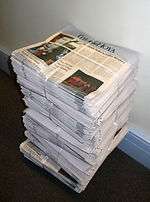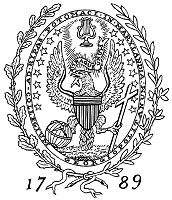The Hoya
|
Georgetown University's oldest newspaper. | |
| Type | Twice-weekly newspaper |
|---|---|
| Editor-in-chief | Mallika Sen |
| Staff writers | 200 |
| Founded | 1920 |
| Headquarters | Georgetown University |
| Circulation | 4,000 |
| Website | www.thehoya.com |
The Hoya, founded in 1920, is the oldest and largest student newspaper of Georgetown University in Washington, D.C., serving as the university’s newspaper of record. The Hoya is a twice-weekly, student-run paper that prints every Tuesday and Friday and online regularly throughout the year, with a print circulation of 6,500 during the academic year. The newspaper has four main editorial sections: News, Opinion, Sports and The Guide, a weekly arts and lifestyle magazine. It also publishes several annual special issues including a New Student Guide, a basketball preview and biannual food and fashion issues.
Although The Hoya is not financially independent from the university, it is produced, managed and edited entirely by students. Over 200 students are involved in the publication of the paper.
History

Founding
The first issue of The Hoya was published on January 14, 1920, under the editorship of Joseph R. Mickler, Jr. Student journalism at Georgetown can be traced as far back as 1824 and the appearance of a hand-copied publication titled Minerva. The Hoya, however, was distinguished from previous student publications by its intent to be a comprehensive university newspaper. The publication took its name from the phrase “Hoya Saxa,” which had been adopted as a common chant at Georgetown sports events in the 1890s. The popularity of the term spread as local newspapers often cited The Hoya, and "Hoya" began to be widely applied to campus organizations and to athletic groups themselves.
First 40 years
Beginning in the 1940s, the publication shifted its main coverage from athletic to campus events. Weathering the Great Depression, World War II, student unrest in the 1960s and funding cuts in the 1970s, The Hoya has appeared almost continuously since its founding, providing a student perspective on issues and events.
In its early years, The Hoya published once a week, focused mainly on internal, campus affairs, promoting student organizations and school functions, and devoted a large part of its coverage to sports. In 1930, The Hoya received the highest rating given to a college weekly publication by the National Collegiate Press Association.
In the late 1930s, international events began to influence content. The Hoya was one of the few student groups to remain active during the war years, and its pages at this time juxtapose coverage of blood drives, war bond programs and alumni casualties with details of tea dances and intramural athletics.
In the post-war era, the paper’s focus returned to internal campus issues, perhaps reflecting the desire of veterans, who made up most of the student body, to return to normal life. The 1950s saw the introduction of two recurring features: the Basketball Preview Issue, which first appeared on December 3, 1957, and the April Fools’ issue.
One of the high points of The Hoya’s entertainment reporting came in 1964, when one of its reporters managed to interview The Beatles, who were in Washington for their first live concert appearance in the U.S. The interview appeared in the February 20, 1964, issue.
1970s and Watergate
In the 1970s, university support for the paper fell significantly; for example, funding was cut more than 55 percent between 1971 and 1975. As a result, the newspaper was forced to increase its advertising fourfold and full page advertisements became common. The paper changed its format from tabloid to broadsheet in the fall of 1976. As the Georgetown student body became more diverse, coverage of minority student groups increased, and articles on the activities and concerns of African American and Jewish students appeared.
Women’s athletics received more detailed coverage, as did the impact of Title IX, and by the end of the decade, references to “girls” and “hoyettes” had been eliminated from the sports pages. Issues in the spring of 1973 contained coverage of attempts by gay students to organize and obtain official recognition.
The years of 1973 and 1974 saw a number of articles on the Nixon Administration and the Watergate scandal. The coverage of Watergate is possibly linked to the fact that a number of players in the Watergate investigations had Georgetown connections.
In the post-Watergate era, perhaps influenced by the event, The Hoya began to run investigative journalism pieces. As a result, the paper went from being viewed as generally supportive of the administration to being one of the university’s chief antagonists. The spring of 1977 brought perhaps the most significant example of this when a story about the firing of five resident assistants led to a university hearing about the entire residence life system and, ultimately, to the resignation of both a vice president and a dean.
1980s and expansion
A number of significant changes to The Hoya’s production occurred during the 1980s. The first issue of 1980, produced on January 25, was the first to appear without the approval of a faculty moderator who had previously been a member of the editorial board. And, after six decades of appearing once a week, The Hoya moved to a twice-weekly schedule beginning in the fall of 1987. Other changes included the adoption of the current masthead in 1982 and the development of standard typefaces for headlines and copy.
1990s to present
The 1990s saw the consolidation and expansion of The Hoya’s entertainment coverage into a pullout arts and lifestyle section titled The Guide. The paper already had a long tradition of providing coverage and reviews of both on-campus and off-campus entertainment, with reviews of off-campus plays and movies first appearing in 1929.
In 1998, The Hoya launched a website. The Hoya also has two official blogs, The Fourth Edition, launched in 2012, which provides a lighthearted take on Georgetown and D.C. news, and Hoya Paranoia, launched in 2008, which covers university athletics throughout the year as well as providing commentary on national and international sports news.
The Hoya joined Facebook in 2008 and has been on Twitter since 2009.
Campaign for independence
In 2004, the newspaper began its official bid to gain financial independence from the university. The Hoya receives around $180,000 from Georgetown University for its operation annually.[1] Late in 2004, the newspaper launched a publicity bid to build grassroots support for the proposition; the school seemed willing to allow the paper to split off, but not with the name "The Hoya", which administrators claimed belonged to the school. In 2007 the school filed for a trademark on the name.
The newspaper relaunched the campaign in early 2008 and circulated a petition that gained over 600 signatures from students and alumni. Though this campaign may have been successful, an April Fool's issue in 2009 put a hold on the independence movement. The issue included several articles that were perceived as racist and insensitive. The newspaper faced significant sanctions for the issue.[1] In a Letter from the Editor in the first issue of the fall 2010 semester, The Hoya acknowledged that the notorious April Fools’ day issue of 2009 was distasteful, but assured its readers that the newspaper would no longer participate in satirical issues. No April Fools’ issues have been published since 2009. Negotiations for independence are currently ongoing, although The Hoya's Board of Directors voted in 2010 to delay independence until the national economy and the paper's financial situation becomes more favorable.
Sections
Editorial
The editorial division is responsible for decisions regarding the content of The Hoya. Senior editors of each section are elected at the end of the fall and spring semesters. Each section’s deputy editors are appointed by the respective senior editor. Senior editors serve one-semester terms at a time, although the editor-in-chief serves for an entire calendar year. The current editor-in-chief is Mallika Sen.
Editorial Board
The Editorial Board is composed of three at-large and two community members, and is chaired by the opinion editor. The Editorial Board, which produces The Hoya’s editorials, is an autonomous body whose views do not represent the opinions of The Hoya.
Publishing
The publishing division manages the business operations. The general manager and departmental directors are hired by the Board of Directors. The current general manager is Brian Carden.
Board of Directors
The Board of Directors oversees the overall strategic direction of the newspaper. The current chair of the board of directors is Sheena Karkal.
Awards
The Hoya has won several national awards, including:
- Associated Collegiate Press National Pacemaker Award, College Newspaper - 2008
- Associated Collegiate Press National Pacemaker Award, Online - 2003, 2005
Notable alumni
Academia
- Leo J. O'Donovan - Former President of Georgetown University[2]
- Scott Pilarz - Former President of Marquette University and the University of Scranton[3]
- Edward F. Sherman - Professor of law, former dean at Tulane University Law School
- Debora Spar - President of Barnard College, member of the board of directors at Goldman Sachs, former professor at Harvard Business School
- Mark von Hagen - Professor of history at Arizona State University
Business
- Andy Billig - Co-owner of the Spokane Indians
- Walter Briggs, Jr. - Former owner and general manager of the Detroit Tigers
- David Wehner - CFO of Facebook
Government and politics
- Jeremy Bash - Chief of Staff to Secretary of Defense Leon Panetta
- Philip Hart - Former United States Senator from Michigan
- Frank Keating - 25th Governor of Oklahoma[4]
- Ron Klain - Former Chief of Staff to Vice Presidents Joe Biden and Al Gore
- Stephen Mull - United States Ambassador to Poland
- Pat Quinn - 41st Governor of Illinois[5]
Media, culture, and entertainment
- Melissa Anelli - Author of Harry, A History, webmaster of The Leaky Cauldron[6]
- William Peter Blatty - Author of The Exorcist, winner of the Academy Award for Best Writing (Adapted Screenplay)
- Quin Hillyer - Columnist for The American Spectator
- Mary Jordan - Journalist for The Washington Post, co-winner of the Pulitzer Prize for International Reporting in 2003[7]
- Mark Landler - Journalist for The New York Times and Bloomberg Businessweek[8]
- J. D. McClatchy - Editor of The Yale Review, literary critic
- Tara McKelvey - Journalist for Newsweek and The Daily Beast
- Don Murphy - Producer of Natural Born Killers and the films from the Transformers series
- Jonathan Nolan - Author of "Memento Mori", co-writer of screenplays for The Dark Knight, The Dark Knight Rises, and Interstellar[9]
- Miles O'Brien - Science and technology correspondent for CNN
- James Johnson Sweeney - Former director of the Solomon R. Guggenheim Museum, former curator for the Museum of Modern Art
- Kara Swisher - Technology columnist for The Wall Street Journal, co-creater of All Things Digital[10]
- Matthew VanDyke - Journalist, documentary filmmaker[11]
Religion
- Joseph Bernard Brunini - Former Bishop of Jackson
- George Henry Guilfoyle - Former Bishop of Camden
In popular culture
- In The West Wing episode "Take out the Trash Day", Sam Seaborn mentions The Hoya, which is investigating an allegedly racist sociology professor whose class is attended by First Daughter Zoey Bartlet.
References
- 1 2 Houppert, Karen (April 7, 2011). "Ink-stained students: Georgetown University's Hoya newspaper is a microcosm of campus journalism". The Washington Post. Retrieved March 19, 2013.
- ↑ https://repository.library.georgetown.edu/bitstream/handle/10822/555380/1971-12-10.pdf?sequence=1
- ↑ http://alumni.georgetown.edu/alumniassoc/alumniassoc_12.html#pilarz
- ↑ Streeter, Bill (January 2011). "New Man at the Helm". ABA Banking Journal. Retrieved June 9, 2015.
- ↑ Mimms, Sarah (January 30, 2009). "GU Alum Replaces Impeached Blagojevich". The Hoya. Retrieved August 24, 2014.
- ↑ Levy, Stephen (April 30, 2010). "Leaky Cauldron Webmistress Discusses Magic Behind Career". The Hoya. Retrieved November 17, 2011.
- ↑ Ronald Klain (12 April 2014). "Tweet Number 454966873323761664". Twitter. Retrieved 14 April 2014.
Proud day for @TheHoya: ex-Hoya editors Mary Jordan and @karaswisher speaking at the #OwnItSummit
- ↑ Palko, Ian (February 16, 2001). "Years on the Hilltop Provide Best Asset For New President". The Hoya. Retrieved August 24, 2014.
- ↑ McGrath, Amanda (May 17, 2002). "Class of 2002 Gathers For Senior Convocation". The Hoya. Retrieved August 24, 2014.
- ↑ Dodderidge, Lili (October 5, 2010). "Top Internet Journalists Talk News". The Hoya. Retrieved February 25, 2013.
- ↑ Russo, Glenn (May 19, 2009). "Alumnus Missing in Libya". The Hoya. Retrieved December 4, 2011.
External links
- The Hoya
- Digital Archives, 1959-1980
- The Guide
- The Fourth Edition
- Illinois Digital Newspaper Collections: Hoya (1959-1980)

